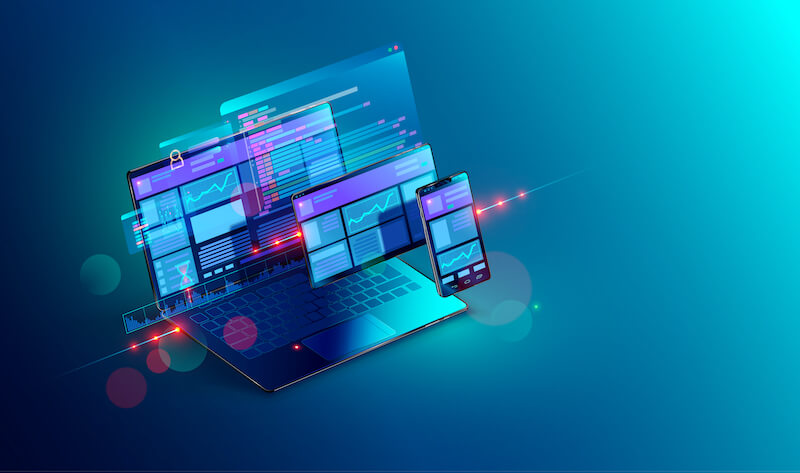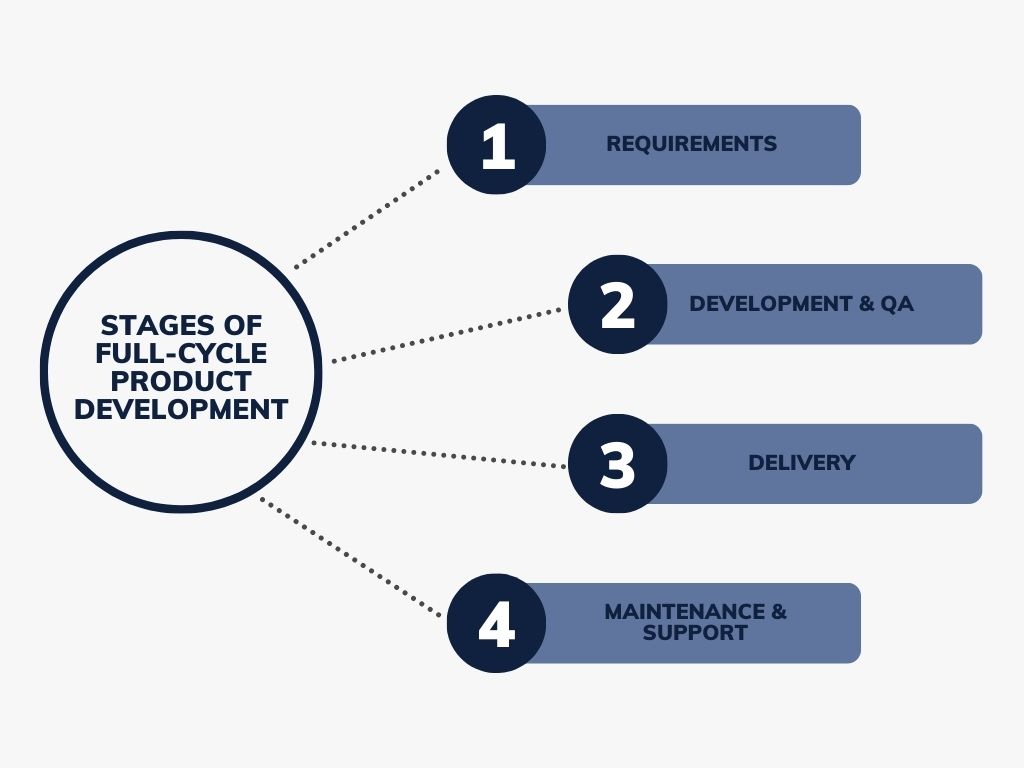
When do you Need Full-Cycle Product Development?

In broad strokes, full-cycle product development is the process of creating an original product step-by-step, from an idea to the market. In this regard, many tech leaders ask themselves, “Is it time to partner with a software product development company?” If you’re still in doubt if it’s the right time for you to go for it, this post will come in handy.
As a company that builds full-cycle product development teams for more than a decade, we can single out three points in the lifetime of a product when our clients decided to approach us:
- The onset of the project: You’ve collected and documented Project Requirements, defined timeframes, budget, and key deliverables.
- Minimum Viable Product (MVP): You’ve validated the idea using a bare-bones version of your product and are gearing up to develop a full-fledged product.
- Modernization stage: Your company uses legacy software applications and technologies that limit your capabilities.
The onset of your project
A perfect kick-off point to delve into full-cycle product development is after ideation. At this point, you should already have a completed Project Scope, a document that reflects your idea of a product, technical requirements, features, and metrics for success. That way, when you reach out to a vendor of custom software product development services, they will gain an understanding of your expectations, which is key to the success of your partnership.
Another important aspect of product development is a budget. Generally speaking, a budget is a cost estimation that typically entails both the direct and indirect costs connected with full-cycle product development, which typically includes administrative, labor, and vendor costs.
While it can be hard to make a precise forecast of how much you are going to spend, your vendor needs to know your financial capacity to make sure they deliver product development services that fit the bill. Moreover, without knowing your budget, it’s impossible to define such critical aspects as team size and other expenses related to tools and facilities that the team needs for full-cycle product development. So, having Project Requirements and budget is an indication that you might be ready to shortlist software product development companies.
A validated Minimal Viable Product (MVP)
With a validated MVP on hand, you know for sure that your idea isn’t built on quicksand and makes your investment into full-cycle product development worthwhile. The next logical step is to reach out to a potential software product development company to develop a range of features on top of your existing MVP. Many vendors of software product development have strategies to ensure that your fledgling version turns into a full-blown product with resounding success. Ideally, the company should lay the foundation for further product growth, allowing your team to focus on other aspects of your product, such as marketing, growth, and attraction of new investments. Thus, having a promising MVP is a good cause to start full-cycle product development.
It’s time to modernize your software
In a world of fast-paced technological advancements, you may find your legacy software outdated and incompatible with modern demands. Using such software may incur various security flaws, an exorbitant cost of maintenance, an inability to scale, faltering user experience, and other issues. In this scenario, a company specializing in full-cycle product development can take up the task of software modernization and provide the following services:
- Cloud migration
- Code refactoring
- New features
- Complete software rewrite
Providers of product development services that specialize in upgrading software can move your product to the cloud, causing minimum disruption to your business.
Teams dealing with code refactoring will apply the changes in a way that your product functionality remains intact. Adding new features to proprietary software is also a common scenario for vendors of software product development who can add new features without affecting your current product state.
Finally, if your case is rewriting your existing product from scratch, a company specializing in full-cycle product development can help you create new functionality and upgrade the product’s architecture based on a modern tech stack.
Stages of full-cycle product development
A product design and development company usually bases its work on several stages that guarantee a coherent full-cycle product development process.
1. Requirements
This stage assumes laying the groundwork for further cooperation with your chosen software product development company. It includes:
- Defining your needs and expectations
- Estimating your budget and timing, IT infrastructure, resources, etc.
- Creating and discussing Product Specifications with your vendor
- Interviewing candidates and team formation
If you have an idea you want to implement using full-cycle product development, you may want to start with some reality check. Your chosen company will help you define if your requirements are feasible in terms of budget, deadline, and technology choice. At this stage, you will also outline the tools you need and roles involved in product design and development, including engineers, software architects, Quality Assurance specialists, DevOps professionals, project managers, etc.
2. Development and Quality Assurance
This is the core stage of full-cycle product development, which includes the following stages:
- Creating software architecture
- Frontend development
- Backend development
- Quality Assurance
- Reporting and Documentation
After analyzing your requirements, the team formed by a software product development company will use technologies to build a product according to your needs. In the course of development, your squad may come across challenges, so you are bound to be in touch with the team and a project manager as you go.
Another important step of full-cycle product development is Quality Assurance, where your product is tested for reliability and security. All drawbacks should be ironed out at this stage. QA is ensured across several levels:
- Module tests: Ensuring all product components function properly.
- System tests: Testing of a product on a high level, such as system and integration testing.
- User Acceptance Tests: Launching and testing a product to ensure the product meets the user experience demands
3. Software delivery
This is the closing stage of full-cycle product development, at the end of which the final version of your product goes live. It includes the following:
- Environment setup
- Migration of code and database
- Final testing and optimization
- Completing Documentation
After your product is tested, your provider of product development services will deliver it to the end-user.
4. Maintenance and Support
After the big day of the launch, your product will require updates and bug fixes. As such, the final stage of full-cycle product development is maintaining and supporting your product. With that in mind, it’s best to inquire your full-cycle product development company if they can offer post-launch product support to ensure that your product stays functional and up-to-date.

Why partner with a full-cycle development company
Partnering with a provider of full life cycle product development is a reliable choice. You can entrust your product development to a vendor who will take your requirements and assemble a fitting team that will handle the SDLC from start to finish, with the degree of autonomy you want that team to have. Besides that, there is a number of other advantages a full-cycle product development company can offer.
A dedicated development team
If you lack the tech expertise in-house, a vendor of full life cycle product development will create a remote team of skilled technologists to work on your product. The concept of a dedicated team assumes that the team members will be fully integrated into your company workflows while they bring your vision to life in the form of a working product.
READ ALSO: Dedicated Development Team: Why you Need it and How to Build one
Your own product development center
If you are apprehensive about managing teams dispersed around the globe, a full-cycle product development company is a good pick. It will ensure your team is co-located in a single development center located in your preferred location. For instance, we at nCube build nearshore and offshore tech centers in Central and Eastern Europe (Poland, Ukraine, Romania, the Baltics), Western Asia (Armenia, Azerbaijan, Georgia), and Latin America (Brazil, Argentina, Mexico).
Your remote unit should be functioning like a well-oiled machine to deliver the product. With a provider of full life cycle product development, it’s simple to manage your remote unit and ensure it’s in perfect sync with the rest of your squad. When the team is co-located and works in close proximity, conducting meetings, reviewing tasks, resolving inconsistencies, and seeking clarifications become simpler.
End-to-end product development
A trusted full-cycle product development company will cover all the aspects of creating a product team for you – from analyzing your requirements to team launch and support all the way through the SLDC. Reputable vendors tend to have experience building product teams that deliver stellar results.
A sustainable team
Your product requires a team that can remain stable over the long haul. A full-cycle product development company is a way to establish a sustainable tech unit that will know the ins and outs of your product, understand your goals and vision, and deliver on your expectations. Having such a team in place means you won’t have to worry about the headache of employee attrition. A reliable provider creates a favorable work atmosphere that encourages team members to stay for as long as you require their services.
Building your software product development team with nCube
Our company specializes in building tech teams that cooperate with the client from start to finish within a full-cycle product development process. We help companies source engineers with the right kind of expertise capable of providing the best solution when it comes to your important mission, be it building a new product or modernizing your proprietary one. The engineers we source are problem-solvers, expertly skilled in their field, with solid communication skills.
Our partners, such as doTerra, Life360, Greenpeace, FlightRight, CrossEngage, and many more have reached us to complete their software product development units in Eastern Europe, including the following roles:
- Frontend & backend developers
- Product designers
- Software architects
- DevOps engineers
- Quality Assurance specialists
- Project managers
We can create your full-blown full-cycle product development team to act as a part of your remote development unit. To launch such a team, we seek candidates who are experienced at their respective stages of the software product development cycle. More than that, team members provided by nCube can join your project at any stage of the product development. If your company is at the stage of MVP, we can provide product designers and developers with experience in your field. For the development and QA part, we can source frontend, backend, and QA specialists. If you’re gearing up to scale your product – we are here to help you with adjusting the architecture and provide skilled DevOps professionals and software architects. As you can see, our goal is to help you with full-cycle product development at any stage.
Our approach is also praised for the following:
- A high level of control. You’ll have a direct impact on the full-cycle product development process, from selecting team members to executing your Project Scope. Our solution lets you have a lot of transparency when it comes to the software product development processes and eventually enjoy a predictable result.
- Direct access to team members. You will communicate with your team members personally, define the workload, assign tasks as you see fit, and generally make all project-related decisions.
- Transparent pricing. You’ll pay for a full-time hired employee (plus a service fee), which puts you in control when it comes to budget.
Let’s connect to chat and see if the time is right for you to dive into full-cycle software development and how our approach can help you with that.
Recommended articles


